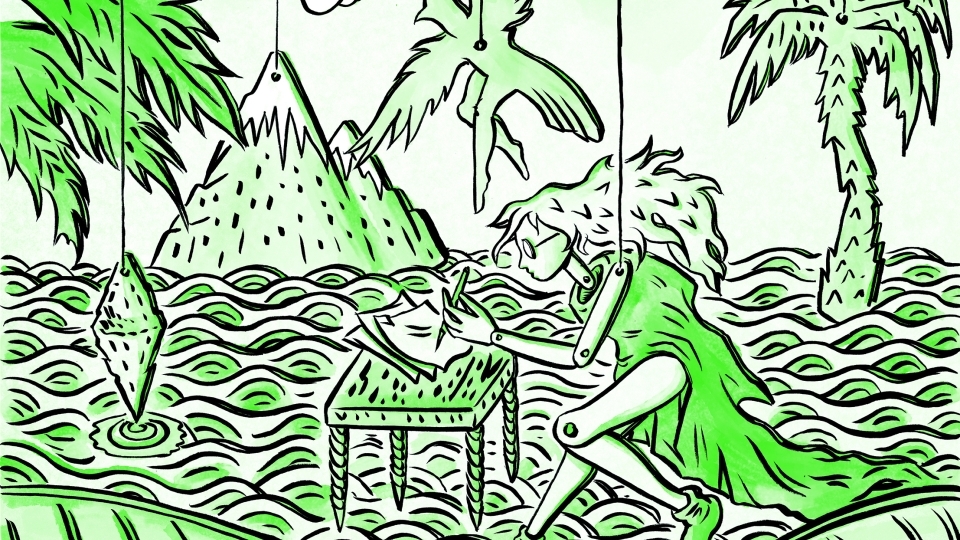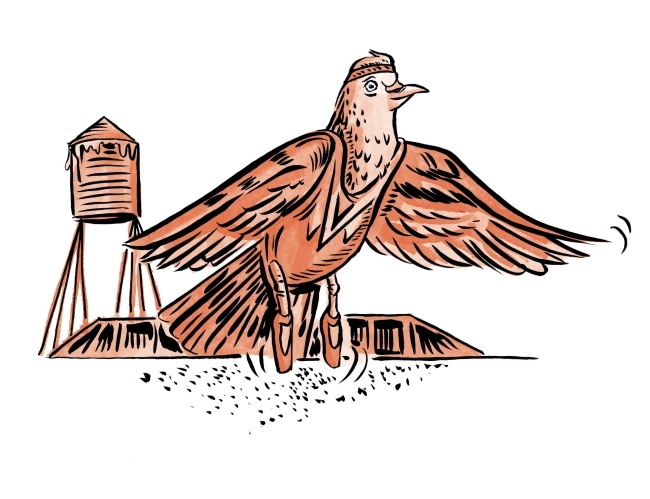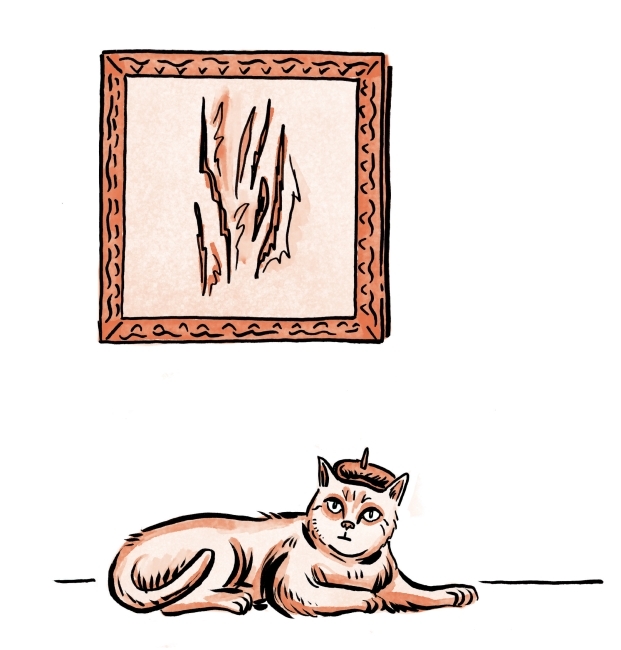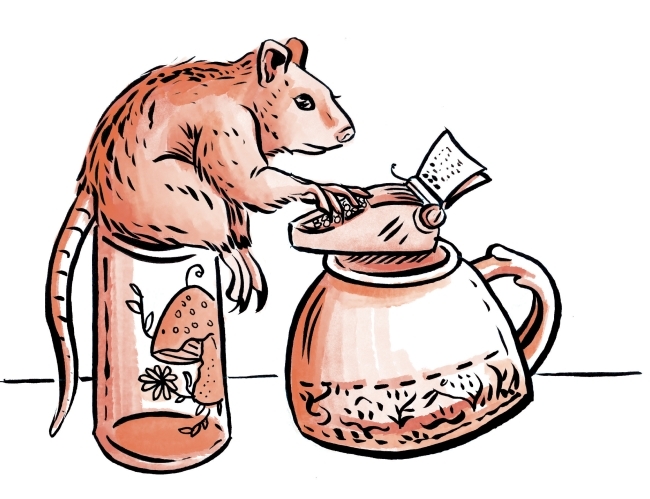Comic Sense: Ali Fitzgerald ’04 Finds Refuge in Art, High and Low
December 30, 2024
- Author
- Mary Elizabeth DeAngelis

Ali Fitzgerald's art career began as a toddler. She’d spend hours bent over coloring books and blank paper, drawing and coloring at her daycare center. At home, she’d head to the big basket of books in the family room, making her way through classics like the Berenstain Bears and the Eloise series. When her mom read to her, she’d memorize the words and try to recreate the picture book illustrations.
Her childhood affection for stories turned into a fondness for comics, and a talent for creating them.
Fitzgerald ’04 received the first of many art awards in kindergarten, and by the time she arrived at Davidson College, had compiled an impressive portfolio. Her art has since earned her prestigious residencies from Maine to Paris, gallery showings, and commissioned public murals in Berlin, Germany.
She’s achieved coveted status as a cartoonist, graphic artist and essayist for some of the world’s top publications. She’s crafted New Yorker and New York Times comics and essays, created the McSweeney’s literary magazine award-winning strip “Hungover Bear and Friends,” and authored Drawn to Berlin, a poignant graphic memoir.
Her art shifts from whimsical to wistful to worried; carefully crafted, succinct social and political commentary on topics ranging from immigration to climate change to grief and the angst of living in the tumultuous 21st century.
“There’s so much cumulatively crazy stuff going on in the world; if you want to learn more and make some sense of it, you go to Ali,” says Sally McGrane, a Berlin-based journalist and author. “She has such intelligence, and insight that’s always sane. She sees things very clearly.”
McGrane met Fitzgerald in 2012 while seeking subjects for a magazine story about Berlin’s growing contemporary arts scene. She shadowed Fitzgerald, who featured prominently in the story, and later became a close friend.
“Her work is so easy to take in but so intellectually nourishing,” McGrane said. “That’s hard to do, but she carries it off with such grace.”
She could entertain herself for hours reading and drawing. She also liked to create things. She’d make these little putty people with adorable little faces. If we couldn’t find a tool or tape or glue, we knew to go to Ali’s room because it was all there.
Ali's Mom
The Art of Grief
From a young age, Fitzgerald had a thoughtful, quiet presence and a love for books and pictures.
Her parents, Cheryl and Daniel, both U.S. Navy officers, met on a ship. After Ali’s birth in Oakland, California, the family moved back to the east coast for new assignments.
While some children crave constant attention, Fitzgerald immersed herself in imagination.
“She could entertain herself for hours reading and drawing. She also liked to create things,” her mom says. “She’d make these little putty people with adorable little faces. If we couldn’t find a tool or tape or glue, we knew to go to Ali’s room because it was all there.”
Ali was four and her sister, Andie, a baby when Daniel Fitzgerald died in a car accident. She has some memories of him, including the time they painted a backyard swing set together. In a 2020 New Yorker Father’s Day essay, “The Dad Archive,” she wrote how his death profoundly shaped her.
“I became a morose and serious kid, a tiny scholar dedicated to the art of grieving,” she wrote. “I had a trunk of my father’s belongings that became an archive I catalogued and re-sorted. It was full of yellowed certificates, holiday greetings, school report cards, and all the other flimsy, flammable things that make up a life.
“I would remove each item with the solemnity of a child monk, studying his loose, impulsive handwriting and smelling the dried sweat on the rim of his baseball cap.”
A neighbor invited Fitzgerald to take drawing lessons with her child, which became an outlet for her grief, and a springboard for her talent.
“That was a turning point for her art life,” her mom, Cheryl Murray, says. So too was a school program geared toward students with artistic gifts. From fourth to seventh grade, Fitzgerald attended the program one day each week to focus solely on art. She spent summers in arts programs, including a memorable one led by a comics artist.
“I’d tell her about an art class, and she’d run with it and do all the work to get into it,” Murray says. “We did everything possible to expose her to art. She appreciated that and was a very willing participant.”
Fitzgerald loved comics like Calvin and Hobbes, The Far Side and Bloom County. Once in a rush, though, her mother unwittingly bought her a comic book intended for a more, um, mature audience.
“It was very racy and wildly inappropriate for a nine-year-old,” Fitzgerald says with a laugh. “That was the first time I realized comics could be dark. I’m very grateful to her for that.”
An Outsider's View
By eighth grade the family moved from Virginia Beach to Hilton Head, South Carolina, to live with Fitzgerald’s grandmother.
While she made some friends, she often felt like an outsider.
“Hilton Head is beautiful, but it was hard to be there and not be rich,” Fitzgerald says. “It felt like a caste system based on money. I had a hard time navigating that.”
Though she took comfort in art and tennis, she struggled.
“There was shame and loneliness and isolation and feeling out of step with the rest of the world at that time,” she says. “I was highly introverted and uncomfortable in my skin, so I retreated into a dream world quite often. I found solace in writing and drawing, which allowed me to express myself without speaking out loud.”
Art became a refuge, and her extensive portfolio earned her a place at The South Carolina Governor’s School for the Arts and Humanities, as well as residencies, awards and scholarships.
When she visited Davidson as a senior, she fell hard for the Katherine and Tom Belk Visual Arts Center (VAC).
“It’s the only school I applied to that had this really beautiful space devoted to art,” she says. “Even though I desperately wanted to escape the south, it felt like a perfect fit.”
Growing Her Practice
Fitzgerald spent her first year at Davidson juggling classes, art and playing on the women’s tennis team. She dropped tennis the following year to devote more time to art.
She created a lot of it in the VAC, including a popular comic strip, “Patent Sweater,” that ran in The Davidsonian student newspaper. She gravitated toward creative writing and poetry, including a memoir class with English Professor Shireen Campbell.
“Davidson excels at teaching writing. I liked both writing and drawing, which is why I ended up making visual narratives,” Fitzgerald says. “Poetry and comics have a lot in common. You have to condense your thoughts. You have to edit a lot. A single sentence carries a lot of weight.”
She spent a semester in Grenada, Spain, enjoying her first foray into European life and culture. When she returned to campus, she had her own studio and worked closely with art professors, including Cort Savage and Herb Jackson. She intensely pursued both painting and making comics.
“I remember her studio bursting with life,” Savage says. “She was a fantastic student, I’m so happy to see her success. I’m a huge fan of Ali’s work.”
He sees his former student in her current pieces.
“Ali was very quiet in class, but she had an intelligence and thoughtfulness with an acerbic wit,” he says. “New Yorker comics need to be pithy and intelligent and that’s what her work is. She’s a very serious person but her work can also be playful.”
Despite her often-cutting commentary, Savage says, there’s kindness.
“She’s not just a social critic, she incorporates the humaneness of the liberal arts,” he says. “That really intersects beautifully with her political awareness. She has a fantastic compositional sense—the way she attends composition and formal elements of her work has a sense of grace in it, even if the subject matter is unsettling.”
Expanding Artistic Outlook
During senior year, Savage encouraged Fitzgerald to pursue a summer residency at the prestigious Skowhegan School of Painting and Sculpture in Maine. The program attracts artists from around the world.
“I was surrounded by all these talented artists. That changed my trajectory and how I thought about the world,” she says. “It really opened my mind—I’ll always be grateful to Cort for that. At Skowhegan I saw a wide variety of art practices, from minimalist sculpture to wild performance art. I realized, perhaps for the first time, that art could be a viable career path and I felt emboldened on my own artistic journey.”
Fitzgerald went on to graduate school at the University of Texas at Austin’s College of Fine Arts, where her paintings sold well at a local gallery. After earning her MFA, she taught art at UT. It was a comfortable lifestyle but Europe, and Berlin in particular, beckoned.
She’d become intrigued by Berlin’s art scene, history and culture reading early- and mid-20th century works by writers like Joseph Roth, who documented Jewish refugees’ paths after World War I and during the rise of Nazi Germany, and Christopher Isherwood, whose novel Goodbye to Berlin inspired the musical Cabaret.
She found parallels between Isherwood’s stories and contemporary Berlin.
“He wrote about the weirdos, queer people and those who didn’t fit into other societies migrating to Berlin during the interwar years,” she says. “When I arrived in Berlin, it felt like a sort of mirrored history, with a flux of people coming from a lot of different places—people who also wanted to live in this open, exciting, atmosphere.”
Returning to Comics
Fitzgerald moved to Berlin in 2009, during the height of a worldwide recession, and found a job teaching English to businesspeople. She resumed drawing comics, which she hadn’t done since Davidson, but kept them to herself in a “sad” folder.
“That was a big change, going from ‘high’ to ‘low’ art,” she says. “That can really mess with your head and people discouraged me from doing it.”
But new opportunities arose, including a commission to paint murals at a Berlin subway station. Inspired by Peter Bruegel the Elder’s 16th-century depictions of peasants (first encountered in a class with Art Professor Emerita Nina Serebrennikov), Fitzgerald’s mural work marked a new artistic chapter.
Her “sad, weird and dark” private comic phase ended, and she began to publish. She created and developed a following for the comic strip “Hungover Bear and Friends,” which won McSweeney’s best column award for 2013 and ran for more than three years. (At McSweeney’s request, she created a new installment last year.)
A New Yorker editor saw and liked her comics, so she pitched ideas to the magazine. Her first New Yorker comic came out in 2016. Others followed, including an eight-page 2023 spread about the late comic writer and novelist Patricia Highsmith, and just recently, a political satire during this year’s presidential race.
Reflections of Refugees
Fitzgerald spent nearly 15 years in Germany, writing the column “Queer Berlin” for the magazine Art21; with pieces also appearing in New York Magazine, The Guardian, the Huffington Post and other publications.
While teaching comic drawing in a refugee shelter, she forged connections with many who’d flocked to Berlin to escape wars in places like Syria and Afghanistan. They told their stories of desperation, grief, anxiety and hope through their drawings, described in her memoir, Drawn to Berlin.
“Amira liked my book of Eloise’s adventures in the Plaza Hotel,” she writes. “I couldn’t imagine two more different places to spend your youth. The Plaza: A towering labyrinth of florid charm and gilded rooms in Manhattan. The Bubble: An inflatable emergency shelter for incoming refugees in Northern Berlin.”
She taught children and adults as they waded through the bureaucracy of seeking asylum. While some recreated the flowers and beauty of their homelands, others revealed troubling memories of violence, drownings in sea crossings, and dead loved ones.
“Children drew guns with alarming clarity,” she writes. “Their ease with weapons reminded me of my own teenage facility for drawing Bart Simpson. We all have our familiar shapes. My hand was branded by youth corporations and 1990s suburban America. What was theirs branded by?”
When she first arrived in Germany, the country welcomed refugees. During the next decade, she watched the rise in the anti-immigration extreme right, which again brought her back to Roth and Isherwood’s writings.
Her book drew comparisons to Roth’s tales of Jews fleeing Russia after World War I and disappearing as Adolph Hitler took over Germany. The shift in public sentiment became palpable.
“You don’t want to draw those parallels but it’s hard to ignore,” she says. “There’s a tension, with rising nativism in the east, infiltrating areas of Berlin where you can see extremist activity. It’s really disheartening, the rise of the new right happened in tandem with the influx of refugees. You see it in the U.S., too—often people don’t realize how closely intertwined the asylum politics of Europe and the United States are.”
Some of her students created successful new lives; she doesn’t know what happened to many.
“The next week Marwan was gone, and I had forgotten to get his email,” she writes in her memoir. “This happened frequently, but it never became a breezy transience. It always felt like losing a friend.”
Her extensive research, words and art drew praise for the book, including this from famed cartoonist Harry Bliss: “Ali Fitzgerald has given us a beautifully crafted and sobering history lesson.”
The Artist's Life
Fitzgerald moved to Paris in late 2023 to be with her partner, an academic she met during a residency there five years before. She’s now a full time artist and teaches workshops at the Berlin Drawing Room and across Europe and the United States.
In 2019 she returned to Davidson to conduct a two-day workshop on visual storytelling. Students—and the college’s expanded arts programs—impressed her. Fitzgerald keeps in touch with Lia Newman, who became director of the Van Every/Smith Galleries in 2013.
“What Lia has done for the art department and galleries can’t be overstated,” Fitzgerald says.
Other changes on campus stood out.
“I wish I could have been there as a student now,” she says. “Some of the things I struggled with, feeling out of place, would be different. It’s much less homogenous. I liked that I saw posters in the Union for LGBTQ+ clubs—that was unthinkable 20 years ago. It seems like a more nurturing college experience these days. Of course, it was a great college 20 years ago, it was just a different era.”
Newman says Fitzgerald’s art reflects a deep commitment to understanding the events—past and present—that shape us.
“Her comics speak to issues that are important to her,” Newman says. “They are smart, factual and funny—adding a little comic relief to what is often a very difficult moment.’’
Fitzgerald says she’s happy with her life in France. She seeks ideas in cafes, libraries and churches, jotting words and making quick stick figure sketches before drawing, writing and editing. She loves animals as characters, pondering what they’d do or say in each situation.
Did those Berenstain Bears books of childhood inspire characters like Hungover Bear?
“Not directly or consciously, but I certainly adored the Berenstain Bears,” she says. “I like the idea of softening and anthropomorphizing animals that are typically depicted as scary or threatening.”
Her next graphic novel, Squeak, Chatter, Bark, an eco-mystery geared toward tweens, comes out in April. It features an 11-year-old girl who enlists friendly animals to help find her kidnapped scientist parents.
In real life, Fitzgerald’s own mother—her earliest first reader—marvels at her journey.
“Ali is living a very bold life. She chose fearlessly to move to Berlin because she’d heard it was the center for contemporary art,” Murray says. “She got great residencies because she earned them. She made every single thing happen for herself.
“She’s a fun, funny, brilliant, nice person. She amazes us all with her talent.”
A Sampling of Fitzgerald's Work
Ali Fitzgerald's work has received critical acclaim. Her graphic nonfiction book, Drawn to Berlin: Comic Workshops in Refugee Shelters and Other Stories from a New Europe was named one of the best comics of 2018 by New York Magazine and won the Independent Publisher’s award for best graphic book of 2019. In 2023, she was nominated for the Cartoonist Studio Prize for her comic for the Museum of Modern Art. In 2025, she will publish Squeak, Chatter, Bark, an all-ages eco-mystery. The drawings below appear in the fall/winter 2024 Davidson Journal magazine.
This article was originally published in the Fall/Winter 2024 print issue of the Davidson Journal Magazine; for more, please see the Davidson Journal section of our website.








